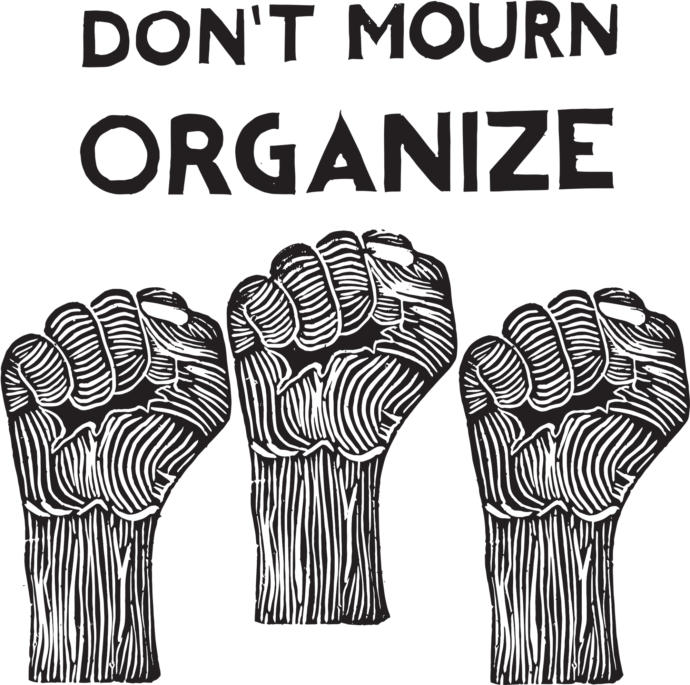New Yorker, January 18, 2017
January 23, 2017

A Seedbed of New Images to Protest Trump
by Colin Moynihan
Originally posted at http://www.newyorker.com/culture/culture-desk/a-seedbed-of-new-images-to-protest-trump

Over the weekend, an organization in Brooklyn called the Interference Archive gave away about five thousand stickers, three thousand printed posters, a thousand buttons, and almost two gallons of red and black paint that ended up silk-screened onto T-shirts, tote bags, and patches in the form of mottoes like “Don’t Mourn, Organize.” The occasion for the giveaway, Donald J. Trump’s swearing-in as President this week, was viewed with gloom by many who showed up on Saturday and Sunday. But one of the archive’s organizers, Josh MacPhee, said the event, called the Inaugurating Resistance Propaganda Party, was meant to provide a bright spot, by giving people a chance to gather and talk and by supplying them with forms of agitprop that could be used during protests scheduled for Washington, D.C., New York, and elsewhere as Trump takes the oath of office.
“Hopefully, these will start becoming part of the visual landscape,” MacPhee said on Sunday as he gazed at an array of posters, including one that featured a black-and-white photograph of Nelson Mandela’s clenched fist accompanied by the words “Ungovernable Anti-Fascist.” The archive was started in 2011 by MacPhee and three others to explore the relationship between social movements and the cultural material that they produce. Since then, the archive has organized dozens of shows and assembled a broad collection of posters, buttons, T-shirts, banners, zines, record albums, audio cassettes, and the like associated with radical leftists of the nineteen-seventies, tenant-rights organizations, women’s movements, squatters in Europe, and the Zapatistas in Mexico, among others. In December, archive volunteers put out a call for posters and stickers that could be used during the Inauguration protests. The archive ended up printing five hundred copies apiece of two poster designs—the “Ungovernable Anti-Fascist” image and one featuring a woodcut-like illustration of people huddled in front of a skyline with the words “Sanctuary Cities Now”—as well as four thousand stickers with defiant messages. Those were supplemented by other posters and stickers that were already on hand at the archive or were donated over the weekend by visitors.
MacPhee, forty-three, is a believer in the ability of political images to send ripples through the Zeitgeist. Most people in large cities are already inundated with advertisements, he said, creating a context in which “our entire environment becomes basically decoration for a conveyor belt to bring us from one point of purchase to another,” but posters and stickers like the ones the archive was distributing stood out because they were so different. “Hopefully, what these things do is they poke little cracks in that artifice,” MacPhee said, as he watched his one-year-old son, Asa, who was mostly sleeping through the Propaganda Party. “The more that you see these things, the more they create a different context for you to walk and think and ultimately act. Imagine having a conversation about what’s going on with the government in front of a giant wall of Coca-Cola ads versus having that conversation in front of a giant wall of these posters with Nelson Mandela’s fist on them.”
For more than four hours on Sunday afternoon, visitors arrived at the archive, which is inside a low red-brick building near the notoriously toxic Gowanus Canal. They rolled up printed posters, used three borrowed button-making machines, and waited to be helped by volunteer silk-screeners. Among those who showed up was Claire Jamison, an actor, writer, and photographer from the East Village. Jamison, twenty-five, said that she first got involved in political protests when George W. Bush was President and she was in high school, in Maine. Now, she said, she was worried that the Trump Administration would cut off or limit access to abortion and birth control. She was planning to travel to Washington for the marches and rallies that would take place during the Inauguration. “I’m trying to push myself to be in the streets,” she said. “I just want to stand up and say this is not the direction our generation wants to move in.
One woman arrived at the archive with a long roll of orange netting of the sort used by construction workers to seal off work sites or, sometimes, by police officers to surround protesters, explaining that it was a near-perfect material to use for lightweight banners. Another visitor, Frances Perez, a twenty-eight-year-old community organizer, took some posters and then put out stacks of bright-yellow cards labelled “Know Your Rights,” which gave tips in English, Spanish, and Chinese for interacting with law enforcement. (One recommended, “If you are detained or arrested by a police officer don’t tell them anything!”)
By mid-afternoon, the posters showing Mandela’s fist had all been taken, and supplies of the others were beginning to run low. In the hallway, some visitors used markers and placards to make their own posters, with messages like “Commander-in-Thief” and “No We Can’t.” As five o’clock approached, MacPhee took a break in a hallway, saying that he was aching from silk-screening duty. Several friends had volunteered to bring to Washington whatever material was left over after the Propaganda Party so that it could be distributed there during the Inauguration, he said. But now, he added, it did not seem as if he’d have to take anyone up on that offer; the archive was almost out of posters. “It means there’s a demand,” he said. “People really want material that expresses how they’re feeling right now.”